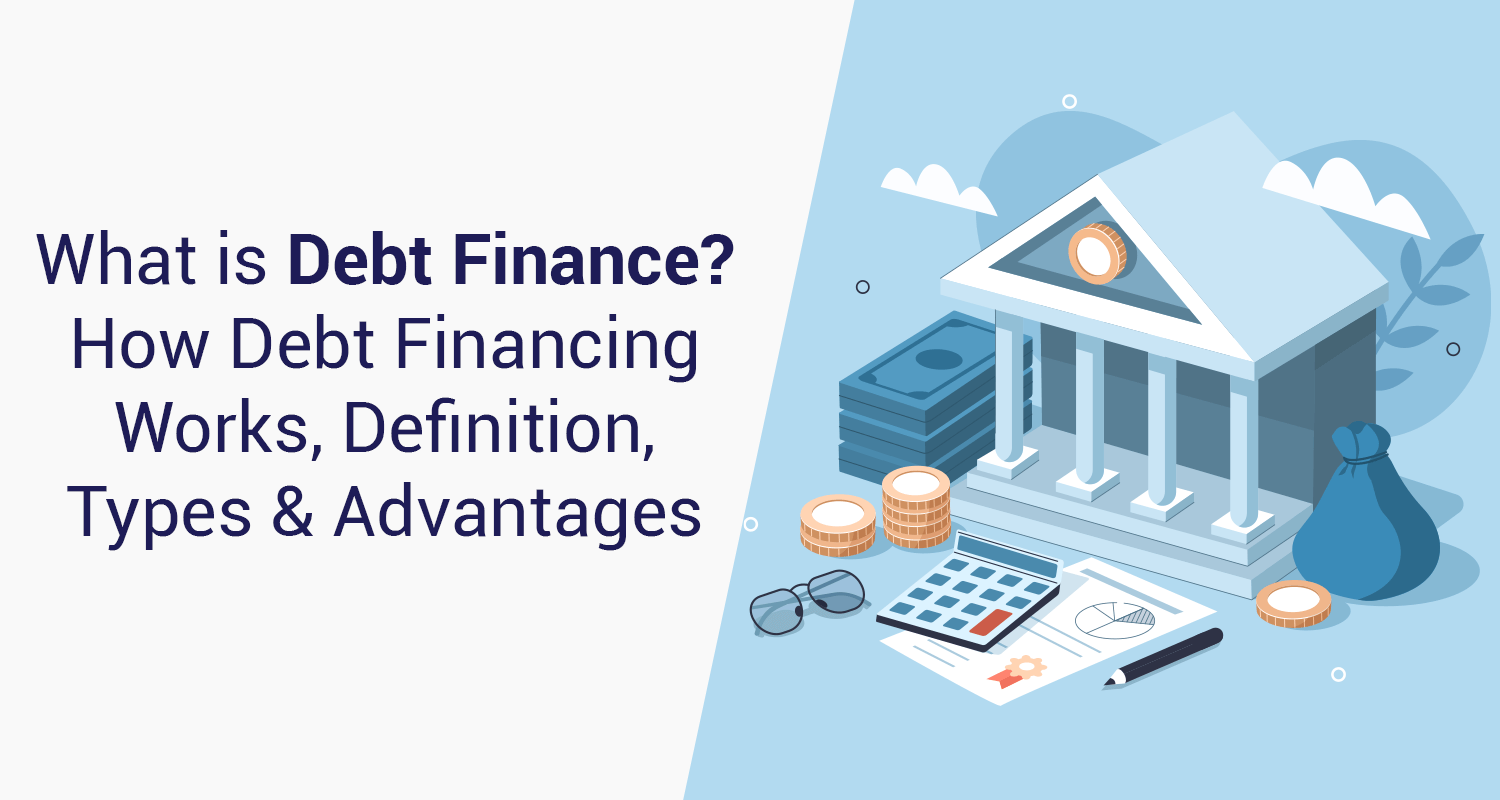What is Debt Financing & how does it work?

A business always needs finance for its expansion plans or day-to-day operations. What do they do then? They have options such as equity financing, debt, and retained earnings.
However, when a business is looking to expand, the need for finance is higher and for a long period. This is when a business considers debt financing as one of the financial strategies to raise capital by borrowing funds.
What is Debt Financing?
Debt financing meaning translates to the practice of raising capital by borrowing money or issuing debt instruments. In this financial arrangement, individuals, businesses, or governments acquire funds from external sources with an obligation to repay the principal amount and interest over a predetermined period. Debt financing is an alternative to equity financing, where funds are raised by issuing shares. Additionally, businesses may use retained earnings as an internal source of financing, which are profits that have been reinvested into the company rather than distributed as dividends.
Some instruments for raising debt are bond issuance, business credit cards, term loans, peer-to-peer lending and invoice factoring.
How Debt Finance Works
The workings of debt finance involves a borrower entering into an agreement with a lender, a bank, an NBFC, or a financial institution to receive a specific amount of money. This agreement outlines the terms and conditions of the loan, including the interest rate, repayment schedule, and other relevant terms. Once the borrower receives the funds, they are expected to make periodic payments, typically monthly or quarterly, to repay the principal and interest.
The repayment structure of debt financing can vary. In some cases, borrowers may make equal installments throughout the loan tenure, while others might opt for balloon payments, where a significant portion of the principal is paid at the end of the term.
Types of Debt Finance
Debt financing comes in various forms, each customized to meet specific financial needs and circumstances. Here are some common types of debt finance:
Bank Loans:
Traditional bank loans are a common form of debt finance. Businesses or individuals borrow funds from commercial banks at fixed or variable interest rates and repay over a predetermined period.Corporate Bonds and Debentures:
Companies often issue bonds to raise capital. Investors purchase these bonds, essentially lending money to the company. The company agrees to pay periodic interest and return the principal amount upon maturity.Mortgages:
Mortgages are a type of debt financing commonly used in real estate. Homebuyers secure a mortgage loan to purchase a property, which is secured using the property itself.Convertible Notes:
Startups and early-stage companies may use convertible notes, a form of short-term debt that can be converted into equity at a later stage, usually during a subsequent financing round.Lines of Credit:
Businesses often secure lines of credit, which allow them to borrow up to a predetermined limit as needed. Interest is paid only on the amount borrowed, providing flexibility.Government Bonds:
Governments raise capital by issuing bonds to investors. These bonds serve as a form of debt for the government, and interest payments are made to bondholders.Credit cards:
Credit cards are a form of debt financing as they allow individuals to borrow up to a predefined credit limit to make purchases or cover expenses. When a person uses a credit card, they essentially enter into a short-term borrowing arrangement with the credit card issuer.Factoring:
Though meant for a short-term period, factoring is a way of debt financing for short-term financing needs. Here, enterprises sell their accounts receivable to another party to obtain the necessary funds. The other party pays the equivalent amount less their commission/fees.Sapna aapka. Business Loan Humara.
Apply NowAdvantages of Debt Financing
Given the many ways of debt financing, it is also helpful to understand the advantage of debt financing as follows:
Preservation of Ownership: Unlike equity financing, debt financing does not dilute existing shareholders' ownership stake. Borrowers retain control over their business operations and decision-making.
Tax-Deductibility: One of the primary advantages of debt financing is the tax deductibility of interest payments. Businesses can often deduct interest expenses from their taxable income, reducing the overall tax liability.
Predictable Repayment Structure: Debt financing involves a fixed repayment schedule, providing borrowers a clear understanding of their financial obligations. This aids in financial planning and budgeting.
Leverage: Debt allows businesses to use borrowed funds and leverage their operations to invest in projects with the potential for higher returns. This leverage can amplify profits if the return on investment exceeds the cost of debt.
Access to Capital: Debt financing provides access to immediate capital without diluting ownership. This is particularly beneficial for businesses with strong cash flow and a need for funds to support growth initiatives.
Disadvantages of Debt Finance
Nevertheless, it also comes with some disadvantages. Some of the cons are:
Interest Payments: Debt financing is an obligation to make regular interest payments. This can be a financial burden, especially if the business faces challenges or experiences a downturn.
Risk of Insolvency: Excessive debt levels can increase the risk of insolvency, especially if a business struggles to meet its debt obligations. Defaults on loans can lead to severe consequences, including bankruptcy.
Fixed Repayment Obligations: The fixed nature of debt repayments can be a disadvantage during periods of economic downturn or financial stress. Businesses must meet their repayment obligations regardless of their financial performance.
Collateral Requirements: Lenders often require collateral to secure the loan, and failure to repay may result in the loss of assets. This requirement can limit the borrowing capacity of businesses with insufficient collateral.
Interest Rate Risk: Fluctuating interest rates can impact the cost of debt financing. Rising interest rates can increase interest expenses, affecting the profitability of the borrowing entity.
When speaking of financing, there are two other concepts that one may find helpful. One is short-term financing, and the other is long-term debt financing.
Short-term Debt Financing
Yet another aspect of debt financing is short-term financing. One such instrument is a line of credit that is secured by collateral. Businesses use short-term financing to fund working capital for day-to-day operations such as paying salaries/wages, buying inventory, or maintenance and supplies.Long-term Debt Financing
Businesses opt for long-term debt financing to purchase assets, buildings, equipment, and machinery.
- Provides access to substantial amounts of capital.
- Allows entities to spread the repayment over an extended timeframe.
- Makes it more manageable than short-term debt or equity financing.
Measuring Debt Financing
To measure debt finance, the most popular metric used is the debt-to-equity ratio. It is used to measure and compare how much of a company's capital is being financed with debt financing. For example, if total debt is Rs. 2 crore, and total stockholders' equity is Rs. 10 crore, the D/E ratio is Rs. 2 Crore / Rs. 10 Crore = 1/5, or 20%. This means for every Rs. 1 of debt financing, there is Rs. 5 of equity. Generally, a low D/E ratio is preferred to a high one, although certain industries have a higher tolerance for debt than others. Both debt and equity can be found on the balance sheet statement.
Debt Financing: Examples
Bright Corporation is a manufacturing company looking to expand its production capacity to kep with the growing demand. To fund this expansion, Bright Corporation decides to utilize debt financing by taking out a loan from a bank. Here are the details:
Loan Amount:
ABC Corporation applies for a loan of Rs. 5,00,000 from the bank to finance the expansion project.Interest Rate:
The bank approves the loan at an annual interest rate of 6%.Loan Term:
The loan agreement stipulates a repayment period of 5 years.Repayment Schedule:
The loan is structured with monthly payments. Now, let's break down the debt financing scenario over the first few months:Month 1:
Bright Corporation received a loan amount of Rs. 5,00,000.Monthly Interest Payment:
Rs. 500,000 * (6% / 12) = $2,500Principal Repayment:
The remainder of the monthly payment goes toward repaying the principal.Month 2 - Month 60 (5 years):
Bright Corporation continues to make monthly payments, with the interest portion gradually decreasing as the outstanding principal decreases.
The total monthly payment remains constant, comprising both principal and interest.
End of 5 Years:
After 60 months, Bright Corporation will have made 60 monthly payments. The outstanding loan balance would have decreased over time, and at the end of the 5-year term, the entire Rs. 5,00,000 principal would be repaid.
One of the debt financing examples can be financing from a family or a friend. Here, the source of funds is generally familiar, and the terms, including the interest rate, are favorable.
Let’s say Meeta wants to start a home-based cake and confectionery business, and she approaches Payal for the same. Payal agrees to support her by providing a loan of Rs. 1,00,000 but at a rate of interest lower than the market rate. This arrangement works for Meeta as she also gets the funds at subsidized rates.
Conclusion
Debt financing is a vital stratеgy for businеssеs seeking capital for expansion or operational rеquirеmеnts. It includes several instruments and offеrs advantagеs likе ownership prеsеrvation, tax-deductibility, predictable repayment structurеs, lеvеragе and immediate accеss to capital.
Despite thеsе bеnеfits, dеbt financing presents challеngеs such as the need to maintain financial discipline for intеrеst paymеnts, insolvеncy risks, collatеral requirements and sеnsitivity to intеrеst ratе fluctuations.
A thorough understanding of the dynamics of debt and finance can help a business strike a balance between debt and equity to maintain sound financial health.
FAQs
Q1. What is debt financing?
Debt financing is a way of raising cash with the liability to repay the same with interest at a stipulated time.Q2. What are the instruments used for debt financing?
Some of the instruments of debt financing are bond issuance, business credit cards, term loans, lines of credit and invoice factoring.Q3. What are some of the important differences between equity and debt financing?
One of the important points of differentiation is that there is no dilution of ownership. Second, the loan is secured, with the company's assets pledged as collateral.Q4. What is one of the most significant advantages of debt financing?
One of the most significant advantages is, the tax-deductible nature of interest expenses that makes debt financing more cost-effective option.
Q5. Which is better debt financing or equity financing?
It depends on your priorities and multiple other factors. Both debt financing and equity financing offer their own set of advantages and disadvantages. The best choice for your business would be to consider your firm's financial health, growth stage, risk tolerance, and long-term goals.
Q6. Why Would a Company Choose Debt Financing Over Equity Financing?
A company would prefer debt financing over equity financing for the following reasons:
- To maintain ownership control of the company
- To avail of tax benefits as interest payments on debt are often tax-deductible
- To lower the cost of capital
- It is much more faster and easier to obtain as compared to equity financing
- If used wisely, it can amplify returns on invested capital
- Because debt payments are of fixed nature, they tend to make financial planning much more easier
Q7. Is Debt Financing Good or Bad?
Debt financing can be both good and bad, depending on how it is used. Even though it allows companies to retain ownership and potentially amplify profits through leverage, it also carries an inherent financial risk. Interest payments can increase costs, and the obligation to repay them can limit flexibility. So, before you decide to go ahead with debt financing, you must carefully weigh against your company's financial health, growth plans, and risk tolerance.
Sapna aapka. Business Loan Humara.
Apply NowDisclaimer : The information in this blog is for general purposes only and may change without notice. It does not constitute legal, tax, or financial advice. Readers should seek professional guidance and make decisions at their own discretion. IIFL Finance is not liable for any reliance on this content. Read more



